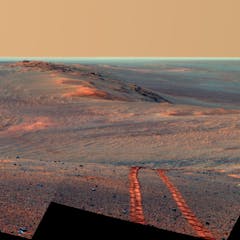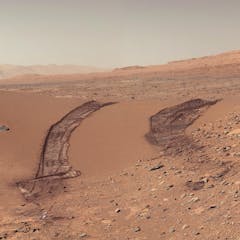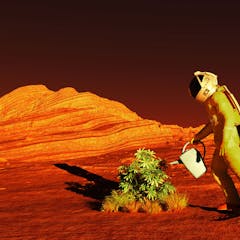
Articles on Mars exploration
Displaying all articles

New ideas will be key to making the mission happen after a report criticised its timescale and cost.

The Perseverance rover has arrived at what’s thought to be an ancient shoreline on Mars.

Among the missions being planned is a huge helicopter drone to explore Saturn’s moon Titan.

Flying the Ingenuity helicopter on Mars is the equivalent of flying one at about 100,000 feet on Earth. Tricky, considering the highest helicopter flight ever recorded maxed out at 42,000 feet.

Perseverance follows in the tracks of Curiosity. The latter’s touchdown on Martian soil in 2012 marked the first successful use of several pioneering space technologies.

Of the three probes to reach Mars this month, only two will land. But they will add to our growing knowledge of the red planet, and the search for evidence of life.

A new country launches a mission to Mars. A space expert explains what this means for the Middle East and the African continent.

US and international law conflicts about who would be in charge if a private company established a Moon base or colonized Mars.

Even on ‘Mars’, humans waste food. And some types of food are more likely to end up in the bin than others.

The atmosphere of Mars is more than 96% carbon dioxide, but the planet is cold because its atmosphere is extremely thin, very dry and further away from the Sun.

An academic describes the career high of working on the most successful mission to Mars, and the little rover that made it possible.

Mars has long captured our imagination, from claims of canals to Martian attacks and now our latest NASA exploration to look inside the red planet.

The moon is our closest neighbour and our best hope for building capacity to explore space.

Augmented reality technology could help recreate familiar sensory experiences from Earth.

If humans are to live on Mars they will need a stable supply of food. Earth plants are not suited to the Mars climate but we can engineer plants that are.

Researchers have found evidence of a large lake of salty water, buried 1.5 kilometres beneath the southern polar ice cap on Mars. So what does that mean for life on the red planet?

The race may be on to send humans to live on Mars, but is it worth the effort – and the spend – when we have our own problems to deal with on Earth.

Beagle 2 shows the fine line between success and failure in Mars exploration. There’s a lot we can learn from it going forward.

Planetary protection protocols try to make sure we don’t seed places like Mars with life from our planet. An astrobiologist argues they’re misguided – especially with human astronauts on the horizon.

Space exploration is exciting - but there are barriers for humans hoping to visit and even stay on planets. Buried ice on Mars could be a water source for interplanetary visits of the future.
